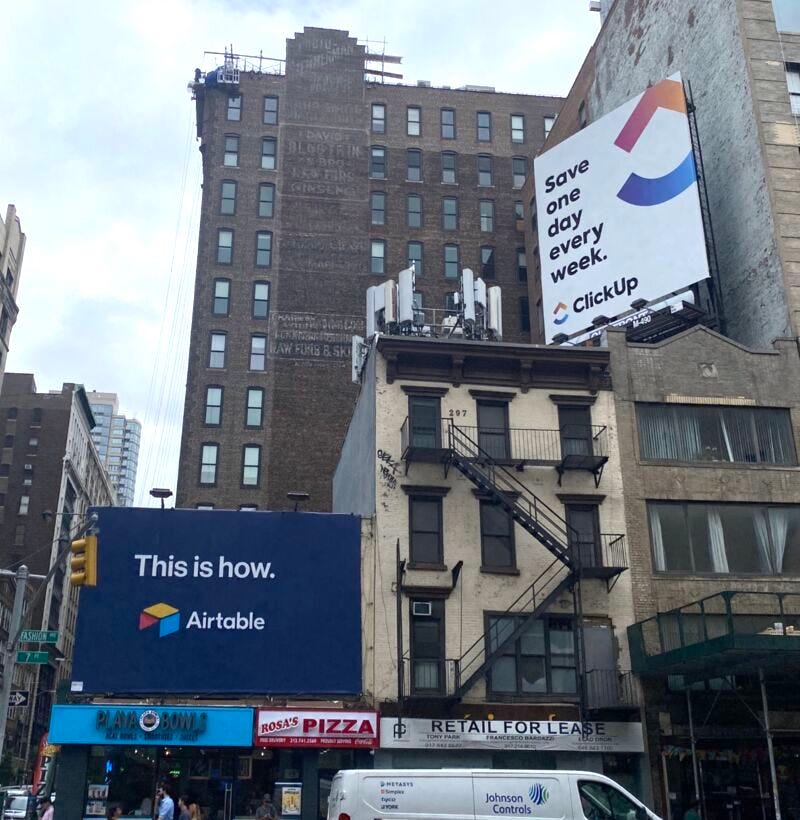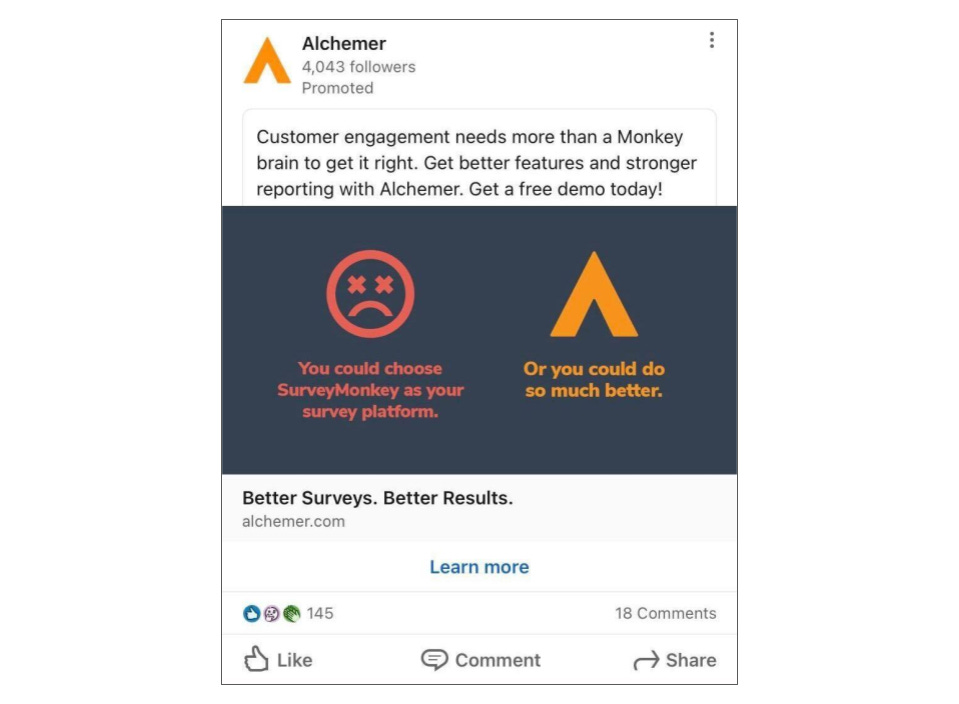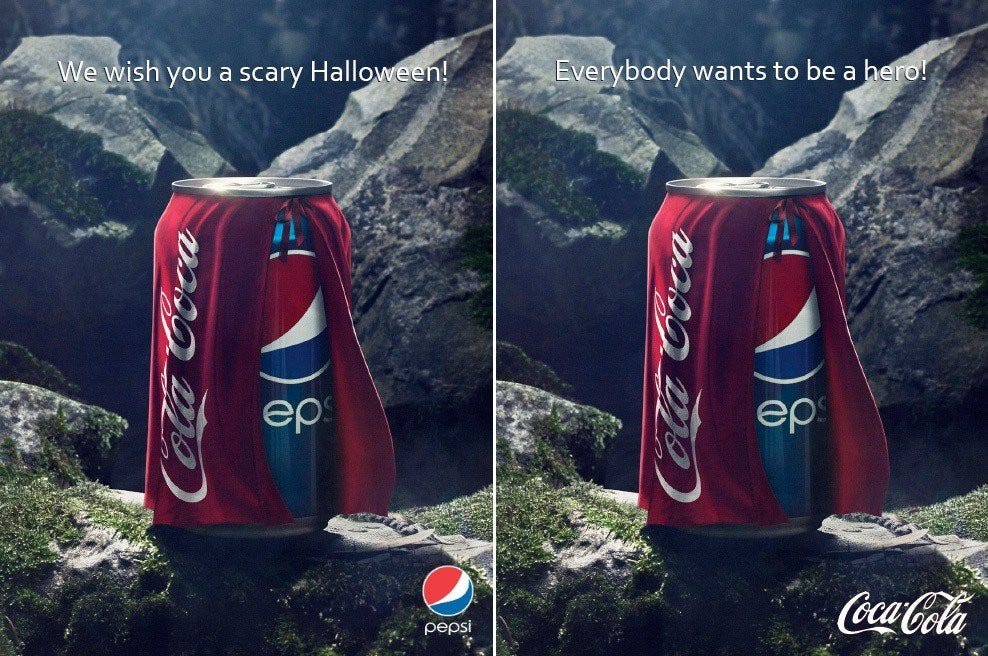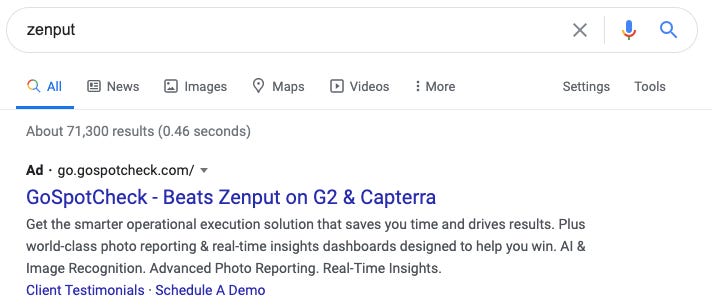The art and folly of marketing against competitors
Examples from ClickUp, Airtable, Alchemer, Highspot, Procore, and more
When you want to market your company against specific competitors, what’s the best way to do it?
A key decision is whether or not to mention competitors by name on the materials you create — on your website, ebooks, advertisements, etc.
My take: regardless of what your competitors do, don’t use their names in your own marketing.
It’s a bad look. Anything you have to say about a competitor is obviously biased, you and your audience know this. It diverts attention away from your own company, towards a competitor whom the audience may or may not even know about.
Yet many companies do mention competitors by name in their marketing, usually out of desperation:
they’re a startup looking to displace the market leader;
a competitor is stealing marketshare and something must be done to stop it;
they’re retaliating against a competitor that is actively marketing against them, disparaging them, or copying their product functionality
And despite my distain for it, I’ll admit some companies pull it off decently — playfully using a competitor’s message to create a stronger one, exchanging jabs with a competitor just for pure entertainment, perhaps more.
However as I show below, I believe the best option is to de-position competitors without directly mentioning or attacking them.
Let’s step back and look at the different ways that B2B companies approach competitive marketing.
4 ways that B2B companies market against competitors
Creative, non-derogatory messaging strategies (Good option) – mention competitors by name, and position themselves as the better option without disparaging them. See ClickUp and Airtable below.
De-position competitors without mentioning them by name (Best option) – spotlight the risks or problems that the audience might run into with some vendors (generally), but that don’t apply to your own company e.g. “watch out for companies that charge by the minute…” when your pricing structure is based on data usage. See Bizo and Burger King below.
Hostile messaging and questionable advertising tactics (Bad option) – attempting to explain why they’re better by intentionally badmouthing or disparaging the competitor. See Alchemer, GoSpotCheck, and Odoo below.
Side-by-side feature comparisons (Acceptable option) – attempt to share an objective product comparison that positions them as the better option, which is also questionable even when using third-party reviews. See Highspot and Procore below.
Check out the ten examples below for more analysis and to see each competitive marketing strategy in practice.
ClickUp
ClickUp vs. everyone
The first thing you see on ClickUp’s website is “One app to replace them all”, then lower on the page you learn more about their product functionality, where they go on to mention 10 competitors by name.
This is brilliant for several reasons:
The tagline “One app to replace them all” is itself competitive, but then mentioning competitors below actually supports and strengthens that tagline – they’re answering the question “ok, who do you replace and how?”
The more competitors they list by name (they list 10), the more they defend that tagline
They don’t disparage the competitors at all, or mention anything about a competitors specific functionality
Airtable
Airtable vs. ClickUp
Pure fun and creativity. This is the kind of stuff you see in consumer brand marketing – like McDonald’s vs. Burger King -esque, not B2B marketing. You love to see it.

Pepsi & Coca-Cola
In 2013, Pepsi attempted to take a shot at Coca-Cola with the ad/image on the left, but Coca-Cola responded creatively using the same exact image with modified copy.
No low-blows here, just pure entertainment with both competitors in on it.
Bizo
Example of de-positioning without mentioning competitor names
One of the better competitive marketing strategies I’ve seen is to create content that spells out the risks/traps/pitfalls that an audience should avoid in your industry – risks that would apply to competitors of yours but not your own solution.
For example, back in my time at Bizo, our marketing team launched an ebook titled “The Top 7 B2B Advertising Traps to Avoid”, that exposed the risks of working with certain kinds of technologies, without mentioning names.
e.g. this de-positioning point:
Misconception: Getting in front of the right company makes for successful B2B marketing
This one is only partly false. Getting in front of the right company is important, but far more important is getting in front of the right people at that company.
In this case, we were constantly competing with ABM platforms that could target ads to people by what company they worked for, while at Bizo we could target people based on their job title, their company name, and other more specific demographic information.
Burger King
Example of de-positioning without mentioning competitor names
In its Moldy Whopper ad campaign, Burger King took a big, risky, indirect shot at competitors.
They didn’t need to mention competitors by name. They showed how, unlike competing burger chains who use artificial preservatives, Burger King is more natural and does not use them – thus their burgers get moldy fast.
Alchemer
Alchemer vs. SurveyMonkey
In the Bad option category we have Alchemer, who shamelessly calls out SurveyMonkey here.

Using the dead-eyed sad face and “Monkey brain” language is not just low-brow, it’s borderline offensive to the audience who may currently use SurveyMonkey. Odd choice, I can’t imagine that this add performed very well.
GoSpotCheck
GoSpotCheck vs. Zenput
Not as rude as Alchemer, but GoSpotCheck mentioned Zenput (my employer) by name which is shady at best and typically not allowed at all on Google – each ad platform has different terms on this.
Odoo
Odoo vs. Netsuite
Odoo has invested in multiple billboard ads like this one, against Netsuite, SAP, and other cloud ERP competitors.
There is no disparaging language here, but this just doesn’t appear to be a productive way for Odoo to market itself. It’s free marketing for Netsuite. There’s nothing that says why Odoo is a better alternative.
Highspot
Highspot vs. Showpad
Highspot’s strategy is 100% about feature/capability comparisons. They go all out against their competitors, with dedicated pages for Showpad, Seismic, and others.
I say this falls into the acceptable category of competitive marketing because Highspot doesn’t badmouth competitors here, they at least attempt to provide an objective comparison against competitors using (outdated) 3rd party reviews to support their claims.

Procore
Procore vs. Autodesk Construction Cloud
On their competitor page against Autodesk, I like that Procore dedicates most of the real estate on its own value vs. focusing on Autodesk e.g. listing the awards they’ve received from G2 and JBKnowledge (a construction consultancy), and customer quotes. They do have a capability comparison chart lower on the page though, for good measure.

While several of the examples above are creative and well-executed, dedicating your own budget, time, energy, and audience-attention to a competitor (mentioning them by name) ultimately seems to not be in your best interest as a marketing team.
What do you think?









